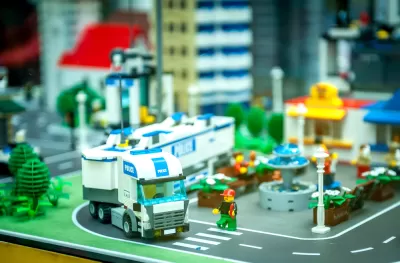A Dutch advocate believes Lego's city sets should reflect streets that prioritize all users. Including bike lanes would be one way for the toy manufacturer to start accomplishing that goal.

Andrew J. Hawkins reports on Lego's curious neglect of bikes: "The streets in Lego’s city sets had space for cars, trains, even tiny storm drains but no designated space for zero-emission, human-powered vehicles like bikes."
"Even worse," adds Hawkins, "it appeared that Lego’s streets were becoming more hostile toward pedestrians over time. As compared to Lego sets from years ago, the cars seem to have grown larger — evolving from four- to six-studs wide — and the roads appeared to be getting wider, while the sidewalks were getting more and more narrow."
A regional councilor from the Netherlands named Marcel Steeman has launched an advocacy campaign o move Lego toward more environmentally friendly representations of the world's built environment.
With the help of Marco te Brommelstroet, an associate professor in urban planning at the University of Amsterdam who tweets under the name Cycling Professor, Steeman submitted two designs to Lego’s “Ideas” project, in which fans are encouraged to submit proposals for new Lego sets. His proposal was simple: more bike lanes.
So far, the efforts has met roadblocks from Lego while winning attention online.

Americans May Be Stuck — But Why?
Americans are moving a lot less than they once did, and that is a problem. While Yoni Applebaum, in his highly-publicized article Stuck, gets the reasons badly wrong, it's still important to ask: why are we moving so much less than before?

Using Old Oil and Gas Wells for Green Energy Storage
Penn State researchers have found that repurposing abandoned oil and gas wells for geothermal-assisted compressed-air energy storage can boost efficiency, reduce environmental risks, and support clean energy and job transitions.

Placekeeping: Setting a New Precedent for City Planners
How a preservation-based approach to redevelopment and urban design can prevent displacement and honor legacy communities.

San Francisco’s Muni Ridership Grew in 2024
The system saw its highest ridership since before the Covid-19 pandemic, but faces a severe budget shortage in the coming year.

Colorado Lawmakers Move to Protect BRT Funding
In the face of potential federal funding cuts, CDOT leaders reasserted their commitment to planned bus rapid transit projects.

Safe Streets Funding in Jeopardy
The Trump administration is specifically targeting bike infrastructure and other road safety projects in its funding cuts.
Urban Design for Planners 1: Software Tools
This six-course series explores essential urban design concepts using open source software and equips planners with the tools they need to participate fully in the urban design process.
Planning for Universal Design
Learn the tools for implementing Universal Design in planning regulations.
Heyer Gruel & Associates PA
City of Moreno Valley
Institute for Housing and Urban Development Studies (IHS)
City of Grandview
Harvard GSD Executive Education
Salt Lake City
NYU Wagner Graduate School of Public Service
City of Cambridge, Maryland




























